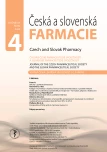Složení mastných kyselin v Centaurea cyanus (L.)
Authors:
Iryna B. Pietkova Liana M. Unhurian Liliia M. Horiacha Viktoriia S. Kyslychenko Iryna O. Zhuravel; Yu. Viiktoria Kuznietsova Leksandr I. Panasenko
Published in:
Čes. slov. Farm., 2020; 69, 194-197
Category:
Short communication
Overview
Práce prezentuje výsledky studie mastných kyselin (FA) ve květech a nati volně rostoucí a pěstované chrpy (Centaurea cyanus (L.)). Analýza byla provedena metodou plynové chromatografie (GC) s vnitřní normalizací. V nati obou typů chrpy bylo identifikováno 13 mastných kyselin. V květech a nati pěstovaných chrp, stejně jako v květech volně rostoucích, převládaly nenasycené mastné kyseliny, zejména kyselina linolová, linolenová a olejová. Kyselina palmitová představovala nejhojněji se vyskytující nasycenou FA.
Klíčová slova:
Centaurea cyanus (L.) – Fatty acids – GC method
Sources
1. Al-Snafi A. E. The pharmacological importance of Centaurea cyanus – a review. IJPRR 2015; 5(4), 379–384.
2. Garbacki N., Gloguen V., Damas J. Antiinflammatory and immunological effects of Centaurea cyanus flower-heads. J Ethnopharmacol. 1999; 68, 235–241.
3. Escher G. B., Santos J. S., Rosso N. D., Marques M. B., Azevedo L., do Carmo M. A. V., Daguer H., Molognoni L., Prado-Silva L. D., Sant’Ana A. S., da Silva M. C., Granato D. Chemical study, antioxidant, anti-hypertensive, and cytotoxic/cytoprotective activities of Centaurea cyanus L. petals aqueous extract. Food Chem Toxicol. 2018; 118, 439–453.
4. Klimas R., Rabiskovi M., Civinskiene G., Bernatoniene J. The diuretic effect of cornflower water extract. Medicina (Kaunas) 2007; 43(3), 221–225.
5. Nowicka P., Wojdyło A. Anti-hyperglycemic and anticholinergic efects of natural antioxidant contents in edible flowers. Antioxidants 2019; 8(308), 1–12.
6. Park J. B. Synthesis, biological activities and bioavailability of moschamine, a safflomide-type phenylpropenoic acid amide found in Centaurea cyanus. Natural Product Research: Formerly Natural Product Letters 2012; 26(16), 1465–1472.
7. Pirvu L., Armatu A., Rau I., Şchiopu S., Coprean D. Centaurea cyanus L. herba, chemical composition and therapeutic potential. Proceeding of the International Symposium 2008; 187–194.
8. Pirvu L., Dragomir C., Schiopu S., Mihul S. C. Vegetal extracts with gastroprotective activity. Part. I. Extracts obtained from Centaurea cyanus L. raw material. Romanian Biotechnological Letters 2012; 17(2), 7169–7176.
9. Fernandes L., Pereira J. A., Saraiva J. A., Ramalhosa E., Casal S. Phytochemical characterization of Borago officinalis L. and Centaurea cyanus L. during flower development. Food Res. Int. 2019; 123, 771–778.
10. Muraveva D. A., Bubenchikova V. N. Phenolcarboxylic acids of the flowers of Centaurea cyanus. Chem. Nat. Compd. 2007; 22(1), 102.
11. Johnson M., Bradford C. Omega-3, Omega-6 and Omega-9 fatty acids: implications for cardiovascular and other diseases. J Glycomics Lipidomics 2014; 4(4), 1–8.
12. Jóźwiak M., Filipowska A., Fiorino F., Struga M. Anticancer activities of fatty acids and their heterocyclic derivatives. Eur. J. Pharmacol. 2020; 871(172937), 1–13.
13. McGaw L. J., Jäger A. K., Staden van J. Antibacterial effects of fatty acids and related compounds from plants. S. Afr. J. Bot. 2002; 68, 417–423.
14. Yoon B. K., Jackman J. A., Valle-González E. R., Cho N.-J. Antibacterial free fatty acids and monoglycerides: biological activities, experimental testing, and therapeutic applications. Int. J. Mol. Sci. 2018; 19(1114), 1–40.
15. Chamras H., Ardashian A., Heber D., Glaspy J. A. Fatty acid modulation of MCF-7 human breast cancer cell proliferation, apoptosis and differentiation. J. Nutr. Biochem. 2002; 13(12), 711–716.
16. Serini S., Piccioni E., Merendino N., Calviello G. Dietary polyunsaturated fatty acids as inducers of apoptosis: implications for cancer. Apoptosis 2009; 14(2), 135–152.
17. Siddiqui R. A., Harvey K. A., Xu Z., Bammerlin E. M., Walker C., Altenburg J. D. Docosahexaenoic acid: a natural powerful adjuvant that improves efficacy for anticancer treatment with no adverse effects. Biofactors 2011; 37(6), 399–412.
18. Spencer L., Mann C., Metcalfe M., Webb M., Pollard C., Spencer D., Berry D., Steward W., Dennison A. The effect of omega-3 FAs on tumour angiogenesis and their therapeutic potential. Eur. J. Cancer 2009; 45(12), 2077–2086.
19. Wen B., Deutsch E., Opolon P., Auperin A., Frascogna V., Connault E., Bourhis1 J. n-3 Polyunsaturated fatty acids decrease mucosal/epidermal reactions and enhance antitumour effect of ionising radiation with inhibition of tumour angiogenesis. Br. J. Canc. 2003; 89(6), 1102–1107.
20. Bala V., Rao S., Li P., Wang S., Prestidge C. A. Lipophilic prodrugs of SN38: synthesis and in vitro characterization toward oral chemotherapy. Mol. Pharm. 2016; 13(1), 287–294.
21. Borkar N., Li B., Holm R., Hakansson A. E., Müllertz A., Yang M., Mu H. Lipophilic prodrugs of apomorphine I: preparation, characterisation, and in vitro enzymatic hydrolysis in biorelevant media. Eur. J. Pharm. Biopharm. 2015; 89, 216–223.
22. Tao Y., Yang F., Meng K., Chen D., Yang Y., Zhou K., Luo W., Qu W., Pan Y., Yuan Z., Xie S. Exploitation of enrofloxacin-loaded docosanoic acid solid lipid nanoparticle suspension as oral and intramuscular sustained release formulations for pig. Drug Deliv. 2019; 26(1), 273–280.
23. Pohodina L., Burda N., Kyslychenko V. Fatty acids composition study of birthwort dutchman’s pipe (Aristolochia clematitis L.) herb and roots. Norwegian Journal of development of the International Science 2019; 31, 53–57.
Labels
Pharmacy Clinical pharmacologyArticle was published in
Czech and Slovak Pharmacy

Most read in this issue
- Vaccines from the perspective of a pharmacist
- Application of inhaled drugs from the pharmacist’s point of view
- Collagen in combination with the acid form of carboxymethylcellulose in the form of a nonwoven textile as a modern wound dressing – formulation, preparation and evaluation
- Composition of fatty acids in Centaurea cyanus (L.)
